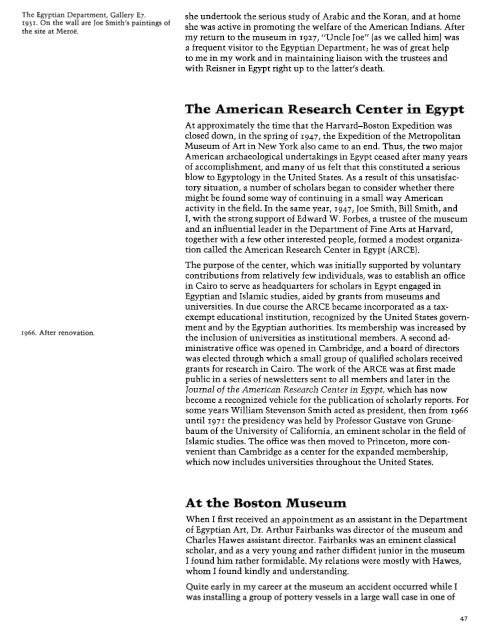Dows Dunham Recollections of an Egyptologist
You also want an ePaper? Increase the reach of your titles
YUMPU automatically turns print PDFs into web optimized ePapers that Google loves.
The Egypti<strong>an</strong> Department, Gallery E7.<br />
1931. On the wall are Joe Smith’s paintings <strong>of</strong><br />
the site at Meroë.<br />
she undertook the serious study <strong>of</strong> Arabic <strong>an</strong>d the Kor<strong>an</strong>, <strong>an</strong>d at home<br />
she was active in promoting the welfare <strong>of</strong> the Americ<strong>an</strong> Indi<strong>an</strong>s. After<br />
my return to the museum in 1927, “Uncle Joe” (as we called him) was<br />
a frequent visitor to the Egypti<strong>an</strong> Department; he was <strong>of</strong> great help<br />
to me in my work <strong>an</strong>d in maintaining liaison with the trustees <strong>an</strong>d<br />
with Reisner in Egypt right up to the latter’s death.<br />
1966. After renovation.<br />
The Americ<strong>an</strong> Research Center in Egypt<br />
At approximately the time that the Harvard-Boston Expedition was<br />
closed down, in the spring <strong>of</strong> 1947, the Expedition <strong>of</strong> the Metropolit<strong>an</strong><br />
Museum <strong>of</strong> Art in New York also came to <strong>an</strong> end. Thus, the two major<br />
Americ<strong>an</strong> archaeological undertakings in Egypt ceased after m<strong>an</strong>y years<br />
<strong>of</strong> accomplishment, <strong>an</strong>d m<strong>an</strong>y <strong>of</strong> us felt that this constituted a serious<br />
blow to Egyptology in the United States. As a result <strong>of</strong> this unsatisfactory<br />
situation, a number <strong>of</strong> scholars beg<strong>an</strong> to consider whether there<br />
might be found some way <strong>of</strong> continuing in a small way Americ<strong>an</strong><br />
activity in the field. In the same year, 1947, Joe Smith, Bill Smith, <strong>an</strong>d<br />
I, with the strong support <strong>of</strong> Edward W. Forbes, a trustee <strong>of</strong> the museum<br />
<strong>an</strong>d <strong>an</strong> influential leader in the Department <strong>of</strong> Fine Arts at Harvard,<br />
together with a few other interested people, formed a modest org<strong>an</strong>ization<br />
called the Americ<strong>an</strong> Research Center in Egypt (ARCE).<br />
The purpose <strong>of</strong> the center, which was initially supported by voluntary<br />
contributions from relatively few individuals, was to establish <strong>an</strong> <strong>of</strong>fice<br />
in Cairo to serve as headquarters for scholars in Egypt engaged in<br />
Egypti<strong>an</strong> <strong>an</strong>d Islamic studies, aided by gr<strong>an</strong>ts from museums <strong>an</strong>d<br />
universities. In due course the ARCE became incorporated as a taxexempt<br />
educational institution, recognized by the United States government<br />
<strong>an</strong>d by the Egypti<strong>an</strong> authorities. Its membership was increased by<br />
the inclusion <strong>of</strong> universities as institutional members. A second administrative<br />
<strong>of</strong>fice was opened in Cambridge, <strong>an</strong>d a board <strong>of</strong> directors<br />
was elected through which a small group <strong>of</strong> qualified scholars received<br />
gr<strong>an</strong>ts for research in Cairo. The work <strong>of</strong> the ARCE was at first made<br />
public in a series <strong>of</strong> newsletters sent to all members <strong>an</strong>d later in the<br />
Journal <strong>of</strong> the Americ<strong>an</strong> Research Center in Egypt, which has now<br />
become a recognized vehicle for the publication <strong>of</strong> scholarly reports. For<br />
some years William Stevenson Smith acted as president, then from 1966<br />
until 1971 the presidency was held by Pr<strong>of</strong>essor Gustave von Grunebaum<br />
<strong>of</strong> the University <strong>of</strong> California, <strong>an</strong> eminent scholar in the field <strong>of</strong><br />
Islamic studies. The <strong>of</strong>fice was then moved to Princeton, more convenient<br />
th<strong>an</strong> Cambridge as a center for the exp<strong>an</strong>ded membership,<br />
which now includes universities throughout the United States.<br />
At the Boston Museum<br />
When I first received <strong>an</strong> appointment as <strong>an</strong> assist<strong>an</strong>t in the Department<br />
<strong>of</strong> Egypti<strong>an</strong> Art, Dr. Arthur Fairb<strong>an</strong>ks was director <strong>of</strong> the museum <strong>an</strong>d<br />
Charles Hawes assist<strong>an</strong>t director. Fairb<strong>an</strong>ks was <strong>an</strong> eminent classical<br />
scholar, <strong>an</strong>d as a very young <strong>an</strong>d rather diffident junior in the museum<br />
I found him rather formidable. My relations were mostly with Hawes,<br />
whom I found kindly <strong>an</strong>d underst<strong>an</strong>ding.<br />
Quite early in my career at the museum <strong>an</strong> accident occurred while I<br />
was installing a group <strong>of</strong> pottery vessels in a large wall case in one <strong>of</strong><br />
47

















